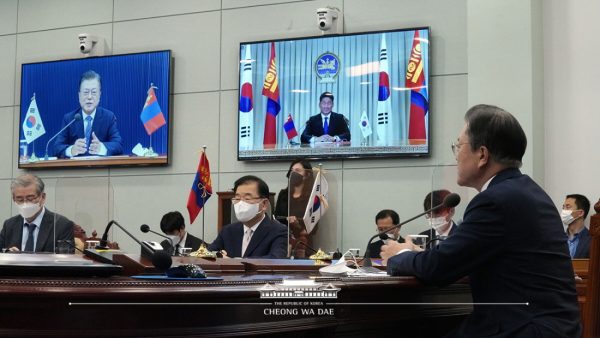
On September 10, Mongolia and South Korea held a high-level online summit. During the meeting between Mongolian President Khurelsukh Ukhnaa and his counterpart, President Moon Jae-in, South Korea became the sixth strategic partner of Mongolia.
The two countries established diplomatic relations on March 26, 1990. In 1991, Mongolian President Ochirbat Punsalmaa’s state visit to South Korea made him the first head of state to visit Seoul after Mongolia’s democratization. Over the past 30 years, as Mongolia’s third-neighbor foreign policy expanded, Mongolia-South Korea relations too blossomed rapidly under a multi-pillared approach. For decades, Mongolia was inspired by South Korea’s development, industrialization, culture, and economic policies as one of the economics “tigers” of East Asia.
In the early 1990s, the fast spread of South Korean pop transformed the Mongolian youth. Old school K-pop bands such as H.O.T and S.E.S were hugely popular in Mongolia. Not only did young Mongolians listen to Korean music, but they also learned the Korean language, imitated Korean styles, and studied and worked abroad in South Korea – the impact was transformative.
Despite these social changes, Mongolia and South Korea’s economic relations and trade remained slow but steady. Between 1994 and 2008, trade between the two countries grew from $23.5 million to $270 million. According to a report from the Korea Economic Institute of America (KEI), “Until 2015, Korea’s direct investment to Mongolia consisted of small businesses (55.5 percent), large companies (27.8 percent), and individual or private companies (16.7 percent) based on investment amounts.” Since 2008, South Korean investment in Mongolia has targeted the mineral industry, small manufacturing, construction, and agriculture. South Korean agricultural and pharmaceutical companies have also invested in Mongolia’s natural medicinal industry in the last couple of years.
On a more political level, Mongolia, and South Korea, as two of the largest democracies in East Asia, both play different but essential roles in solving complex tasks in the region. Given South Korea’s geographical specificity, Seoul needs to make tough decisions concerning North Korea. Those in the West may not feel the immediacy of North Korea’s nuclear threat, but in East Asia, it is a ticking bomb. North Korea’s repetitive provocations – such as its cruise missile tests over the weekend – not only threaten regional peace and security but also complicate political and economic solutions to overcome its protracted desolation. While neighboring countries like China, Japan, and South Korea, have sought deterrence in the past, Mongolia continued to push for peaceful dialogue, using its small-state mediation skills. Moreover, Mongolia’s non-nuclear weapons state status (NNWS) is a powerful boost to its credibility on the topic of denuclearization.
Since 2014, Mongolia has been hosting the Ulaanbaatar Dialogue on Northeast Asian Security to continue international debate and conversation on the security issues of the region. According to the Mongolian Ministry of Foreign Affairs, in 2017, the conference upgraded to Track 1.5 level, involving both government delegates and academia.
During the Mongolia-South Korea high-level summit on September 10, Khurelsukh and Moon noted that over the past 30 years, Mongolia-South Korea relations and cooperation have developed rapidly. Moon congratulated the president of Mongolia on his election victory and said he was pleased to be the first foreign president to hold a summit with Mongolia’s new head of state.
Moon also highlighted the importance of Mongolia in South Korea’s New North Policy. During his speech, he pledged South Korea’s cooperation in Mongolia’s long-term development plan, Vision 2050.
The decision to advance Mongolia-South Korea’s relations to a strategic partnership level builds on the “Protocol on the Establishment of Diplomatic Relations” of 1990 and the joint statements signed between Mongolia and South Korea during their 1991, 1999, 2006, and 2011 summits. The consistent strengthening of the two countries and their people’s relations, under the principles of “complementary cooperation in the 21st century,” has been reflected in the changing status of the relationship: a “good neighborly and friendly cooperation partnership” in 2006, a “comprehensive partnership” in 2011, and now a strategic partnership.
Under the newly established Mongolia-South Korea strategic partnership, the two countries have agreed to play an important role in strengthening regional and international peace and sustainable development under a multi-pillared foreign policy approach.
The Mongolia-South Korea Strategic Partnership Joint Declaration reaffirms their commitment to strengthening political trust and expands cooperation between the two parliaments as well as stabilizing and enhancing dialogue mechanisms on security, defense, and foreign policy issues. Moreover, Khurelsukh and Moon agreed to deepen mutually beneficial and complementary economic relations using the advantages and development potential of the two countries, such as South Korea’s advanced technology and Mongolia’s rich natural resources.
The Joint Declaration further stated that South Korea would continue to seek various cooperation projects with Mongolia, supporting Mongolia’s post-epidemic economic recovery through official development assistance. South Korea also seeks cooperation in Vision 2050-based projects and offered to assist in Mongolia’s policy implementation process. The Joint Declaration also touched on education, science and technology, environmental issues, public health, culture, and tourism.
Mongolia’s strategic partnership with South Korea once again shows its foreign policy strength. In July 2021 alone, Mongolia held high-level talks with China, Japan, South Korea, the United States. Given the increasing significance of the Asia-Pacific region, Mongolia cannot afford to bandwagon with one regional player. In the past, Mongolia has established strategic partnerships with Russia, China, Japan, India, the United States, and now South Korea.
This newly established partnership presents new opportunities, a new level of dialogue, and increased collaboration between the two governments and the people of Mongolia and South Korea. It is paramount for both governments to utilize and allocate resources correctly to produce a genuinely fruitful outcome.

0 Comments